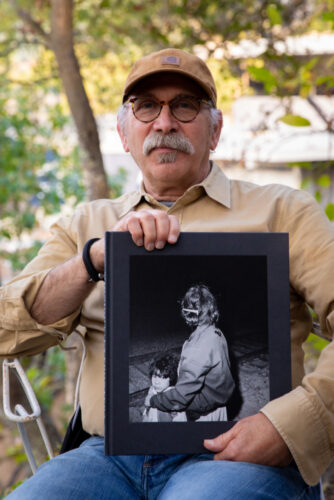Professor Light Captures Darkness at the Border
By JohnTaylor Wildfeuer
Mothers handcuffed to their children, a full-grown man stuffed into a drainpipe, a family of three crammed together in the boot of a car. Under the cover of night they were found and detained by border patrol officers, their moments of fear, loss, and resignation caught in the glow of Ken Light’s Hasselblad camera, and now enshrined in “Midnight: La Frontera”.
From 1983 to 1987 Light, a professor at UC Berkeley and City College, rode with Border Patrol agents in Otay Mesa, San Diego, north of the border between California and Mexico, to document the experience of immigrants in the moments they were detained. With these and photographs taken of agricultural workers in California’s Central Valley, he published To the Promised Land in 1988.

Over thirty years later, Light has returned to those contact sheets stating that images that were unpublished or underappreciated at the time now had “a new power, and a new meaning given the current crisis”.
He spoke of the experience of reexamination saying, “The more I dug and the more I saw what I had photographed back in 1983 the more excited I got, I really wondered how did I miss this?” As he drove home from photographing the Northern California complex fires, he revisited his observations of the southern border.
Light spoke of changes in the attitudes of immigrants met with Border Patrol agents at the border. Whereas detainees in 1983 were mostly compliant, by 1987 he says, “The word spread that if you ran five different directions, there was a better chance for you to get out”.
By contrast, in 2019 while working on a film at the border with a colleague from the journalism school at UC Berkeley, Light says that, “While we were filming a group of people literally came through the fence and sat there waiting to be apprehended”.
In that time Light has seen little change in the attitudes of border patrol agents, saying, “It’s a job and you’ll talk to some agents and they have very heavy hearts, and it’s difficult for them. And you’ll talk to other agents and they’ll describe it as like hunting.”
According to the Fiscal Year 2019 ICE Enforcement and Removal Operations Report, “ICE removed 267,258 individuals, an increase from the 256,085 removals in FY 2018”. In an interview with Huckmag in July 2020, Light remarks, “This moment is a repeat of the 80s, it’s not a new story”.
Light shared his thoughts on the cycle of deportation saying, “Part of the idea of the book is for people to reexamine this whole era of immigration and try to understand why have we not solved this problem, and why is it still going on, and who are these people?”
Immigration and the struggle for American citizenship have been a topic of constant debate in the public forum. In 1988, the Washington Post ran an article with the headline “1980s Expects to Set Mark as Top Immigration Decade”, and last month the Washington Post published another that read “As U.S. expels migrants, they return, again and again, across the Mexico border.”
To this point, Light recalls, “One of the agents I photographed with told me a story where he was working one night and he caught a group and he sent them back. The second night he caught the same exact group, sent them back. The third night he caught them again, on the third night this immigrant said to him ‘Don’t you get a day off?’ He said ‘In fact the next day was my day off and that was the last time I ever saw them’”.
In the 1988 Washington Post article Alan Kraut, an American University history teacher, states “There is an old immigrant saying that goes, ‘America beckons but Americans repel.'”
Dorothea Lange, a Depression Era photographer whose work has influenced many including Light, has said of photography that the object is not the photographs, but their consequences.
The desired consequence of “Midnight: La Frontera” Light says is, “…that people will look at the book and start to wonder why do we have this policy and who are these people? The people in the pictures could be City College students, or their parents, or their grandparents. They could be your professor, they could be a doctor or a lawyer. They could be a gardener, they could be a domestic worker, they could be a bus driver. The people in those pictures are part of the fabric of America.”
Ken Light’s 86 photographs, developed in the darkroom for “Midnight: La Frontera”, were purchased early in 2020 by the San Francisco Museum of Modern Art. When the museum reopens, he will be there to share his pieces of the fraying fabric of America, to continue to document the undocumented.

It is sad that nothing is commented about how the governments and countries these people are fleeing do not provide jobs, access to food, medical care, nor free schooling for them, and they feel they can get everything they need for free in America. Many cases adults often take children who are not theirs as their own and try to cross the border to get benefits. I understand the sympathy of the American people, but, at the same time, one has to look at the reasons they are coming in the thousands and how it is affecting the social systems in place in the states most affected.